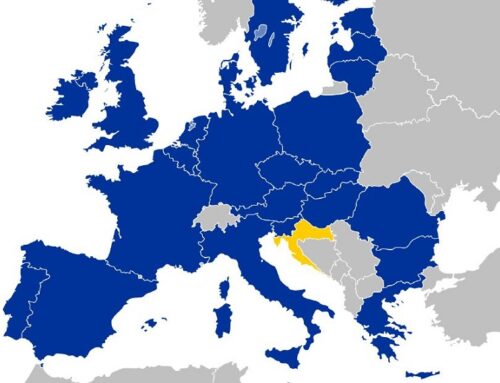Introduction
After 1989, the newly post-communist states engaged in an extensive process of transformation from communism and planned economy to democracy and market capitalism. Though the speed and depth of this transformation differed vastly across cases and even in time, there quickly emerged a common theme: accession to the EU. With many countries in different stages of readiness declaring accession to the EU as their primary foreign policy goal, reform quickly happened in tune with what was desirable in the Union. For its part, the EU made apparent its willingness to act as a guiding light for the fledgling democracies. Conditionality was imposed through the adoption of the acquis communitaire and through the Copenhagen criteria. The acquis refers to the totality of EU rules, laws and regulations that have to be adopted by a candidate country. The Copenhagen criteria define whether a state is eligible at all to become a candidate. By becoming a member of the EU in 2007, Romania clearly fulfilled the requirements imposed through the Copenhagen criteria and the acquis communitaire. However, the level of reform achieved in the area of rule of law was considered insufficient. This led to the creation of a novel form of EU conditionality: the Cooperation and Verification Mechanism (CVM). Now in place for 10 years, both the EU and Romania, as well as EU scholars, are taking stock of the progress achieved under the external influence of the CVM. By using Vachudova’s theoretical framework, this paper aims to assess how the CVM influenced state transformation in Romania, with particular focus on the 5 and 10 year mark reports. In particular, it seeks to find whether Vachudova’s (2012) claim that tying Schengen accession to CVM benchmarks increased the pace of reforms.
The first part of the paper further outlines the theoretical framework, part two offers a look at the functioning of the CVM and its relation to the rule of law in Romania, whereas part three compares the 2012 and 2017 progress reports. The 2012 and 2017 progress reports were chosen because, in addition to offering the usual annual update on the progress achieved, they also each offer an overview of the progress up to that point in time. Moreover, they present a highly contrasting view of the country’s achievements, with the 2012 report being issued at a time of political crisis while the 2017 one marked a positive streak that was lauded by the Commission.
The EU’s Passive and Active Leverage
When theorizing about the influence of the EU on the process of state transformation in ex-communist countries, Vachudova (2005: 63) differentiates between passive and active leverage of the EU: “By passive leverage I mean the attraction of EU membership, and by active leverage I mean the deliberate conditionality exercised in the EU’s pre-accession process.”
Passive leverage includes political and economic benefits of joining the EU. The primary political benefits are the protection afforded by EU rules and the ability to have a voice in the decision-making process of the EU, whereas the main economic benefits are: access to EU market, transfers from EU budget, increased investment growth, increased entrepreneurship skills. These benefits are further shaped by the cost of exclusion from the EU and the EU’s treatment of non-member states (Vachudova 2005: 65). For the EU to be able to exert its passive leverage on countries, the countries in question must be credible candidates.
Poland, Hungary, the Czech Republic, Slovakia, Bulgaria and Romania were the countries that emerged as most credible candidates after the 1989 revolutions. For the first years after the revolutions, the EU only exerted passive leverage over the countries’ transformations. While the stated foreign policy priority of these countries was joining the EU, the domestic reforms employed did not necessarily reflect that. Broadly speaking, countries tended to follow either the liberal or illiberal trend imposed by the kind of political power shifts that occurred in 1989. In Poland and Hungary (and later in Czech Republic more than in Slovakia), where the communist elite was displaced by a coalition of democratic opponents, the liberal trend tended to hold after 1989 and was reinforced by the EU’s passive leverage. In Bulgaria and Romania, on the other hand, where the communist elites were toppled by a faction of their own party, illiberal trends continued with behaviors such as rent seeking and corruption remaining prevalent. “Since the future requirements of membership were not specified and surveillance of domestic politics was only sporadic, from 1989 to 1994 governing elites in Sofia, Bucharest and Bratislava could thus demand EU membership while pursuing rent-seeking domestic strategies with impunity” (Vachudova 2005: 73).
Applying for membership triggered active leverage and put the countries’ domestic policies and politics under close scrutiny of the EU. The pre-accession requirements are massive and nonnegotiable. Active leverage materialized through the Copenhagen political and economic criteria, the acquis communitaire, as well as through a selection based on meritocracy and through the creation of an asymmetric interdependence (Vachudova 2005: 108). Meritocracy refers to the fairness of the selection process, with candidate countries being considered for accession according to their commitment to, speed and depth of reform. The asymmetric interdependence was created due to the fact that while candidate countries depended on the EU greatly, the EU depended little or not at all on them. “While asymmetric interdependence and enforcement both give credibility to the EU’s threats of exclusion, meritocracy gives credibility to its promises of eventual membership.” (Vachudova 2005: 112)
While the EU’s leverage can change from passive to active once a state officially applies for candidacy, once the accession process is completed, active leverage ceases to work as powerfully. The development of the CVM was therefore novel not just for its specificity (it applies only to Romania and Bulgaria), but also because it was a way to extend active leverage of the EU. How and why are questions that will be addressed in the following section.
The CVM and the Rule of Law
The CVM was developed to assist Romania and Bulgaria in reforming their judicial system, their capacity to fight against corruption and organized crime. Unlike the Copenhagen criteria and the acquis, which apply uniformly to all candidate states, the CVM is highly specific and sets separate benchmarks for Romania and Bulgaria, according to their problematic areas. The benchmarks set for Romania in December 2006 are:
“1. Ensure a more transparent, and efficient judicial process notably by enhancing the capacity and accountability of the Superior Council of Magistracy. Report and monitor the impact of the new civil and penal procedures codes.
- Establish, as foreseen, an integrity agency with responsibilities for verifying assets, incompatibilities and potential conflicts of interest, and for issuing mandatory decisions on the basis of which dissuasive sanctions can be taken.
- Building on progress already made, continue to conduct professional, non-partisan investigations into allegations of high-level corruption.
- Take further measures to prevent and fight against corruption, in particular within local government.” (European Commission 2006: 2)
Romania regularly reports to the Commission on the degree to which these benchmarks have been fulfilled, and the Commission offers technical assistance. The main reports are published in July, and the so-called interim, technical reports or updates in February.
Externally imposed reform of the rule of law is seldom sustainable. Not even EU conditionality, as extensive and thorough as it is, can fully address the issues that are problematic. Aspects of the rule of law such as judicial impartiality and independence are mostly subject to indirect EU leverage during the accession process and therefore notoriously difficult to reform. The rule of law therefore remained one of the last stumbling blocks Romania had to address before EU accession. However, worries that the path of reform would not hold, as well as discontent with the level of progress already achieved precipitated the adoption of the monitoring device known as CVM. Achievement of the CVM benchmarks depends highly on the commitment of domestic authorities to institutional change (Vachudova & Spendzharova 2012: 5).
It is therefore of little surprise that the CVM reports offered mixed reviews of Romania’s performance over time. “In Romania, the political will to tackle domestic institutional reform has been uneven since 2007. There was a surge in activity in the run up to accession, but much of the political elite responded by closing ranks and working to dilute or remove the curbs on corruption that were implemented at that time” (Vachudova & Spendzharova 2012: 10) The momentum for judicial reform and fight against corruption gained in 2004 by the election of the Băsescu administration largely halted by 2008. The crisis pushed economic concerns to the forefront of the 2008 elections and commitment to rule of law reform seemed to be flagging. The Parliament continued its habit of closing rank around its own and putting roadblocks in front of high level corruption cases. Additionally, the ANI (Agenția Națională de Integritate – National Integrity Agency), whose creation was lauded by the CVM reports, was attacked in Parliament and in the Constitutional Court, with most of its activities being declared unconstitutional (Vachudova & Spendzharova 2012: 11).
The apparent backsliding of the reform momentum and the attack on ANI was penalized through a critical CVM report in 2010: “the assessment of the Commission points to important shortcomings in Romania’s efforts to achieve progress under the CVM. Romania does not show sufficient political commitment to support the reform process. The amendments to the law on the National Integrity Agency voted on 30 June represent a serious step back. The law puts at risk the positive track-record which ANI had achieved and puts Romania in clear breach of its accession commitments.” (European Commission 2010: 7)
In 2011, accession to Schengen was blocked indefinitely for Romania and Bulgaria. Though the Commission itself was reluctant to tie CVM benchmarks to Schengen access, public statements from officials of six EU member states made it clear that access to Schengen depended on Bulgaria and Romania’s capacity to prove commitment to judicial reform and anticorruption (EURACTIV 2011).
A further crisis followed in 2012, with president Băsescu under threat of being impeached for the second time. The conflict between the presidency and the government was a result of the cohabitation imposed by an opposition majority in Parliament. “As a reaction to this political crisis, the European Commission decided to intervene and to use the July 2012 Report as an instrument to avoid the spreading of this crisis. It decided to do so because it did not have another instrument to deal with what was going on in Romania and because CVM Reports had proved to be efficient, in the sense that the Romanian authorities generally took into account the recommendations that are part of such Reports.” (Carp 2014: 9)
While the CVM reports were usually taken into consideration by the Romanian government (which is evidenced by the reforms employed), it was not until the confluence of the 2011 blocked accession to Schengen and the 2012 constitutional crisis that an enduring upwards trend of reforms can be detected. “Linking Schengen entry to satisfying CVM benchmarks has helped trigger reform.” (Vachudova & Spendzharova 2012: 13) In the following section, a comparison of the 2012 report and the 2017 report will seek to prove whether this claim holds water.
The CVM Reports at the 5 and 10 Year Mark
The 2012 constitutional crisis led to the adoption of the most critical CVM report to date. The importance of this report is doubled by the fact that it offered an assessment of the progress made in the five years since the adoption of the CVM. The accompanying press release called for “urgent action needed to demonstrate commitment to rule of law and judicial independence” (European Commission 2012).
The mixed record of the first five years of the functioning of the CVM was recognized by the Commission (2012b: 2): “During these five years there have been periods of progress and setbacks, times when cooperation has worked well and times when the mechanism has been resented and resisted”. While Romania has managed to create the basic legal framework required by the benchmarks, there remain serious problems to be addressed in its implementation (European Commission 2012b: 4). Judicial independence was singled out as a continued area of concern (European Commission 2012b: 5). Though the activity of the DNA and ANI was noted, both agencies suffer from a lack of credibility as a result of political attacks and delays in prosecution. Despite a high number of indictments in high-level corruption cases delivered by the DNA, shortcomings in judicial practice still taunt the agency (European Commission 2012b: 11-12). Inconsistency and low levels of efficiency also haunt the Romanian judicial system (European Commission 2012b: 7-8).
Furthermore, the 2012 constitutional crisis raised doubts about Romania’s commitment to the rule of law. Any progress that was made according to the benchmarks of the CVM was therefore seen from the prism of this crisis. “Political challenges to judicial decisions, the undermining of the constitutional court, the overturning of established procedures and the removal of key checks and balances have called into question the Government’s commitment to respect the rule of law and independent judicial review” (European Commission 2012b: 3). The credibility of the irreversibility and consolidation of the progress achieved thus far was seriously undermined by the crisis. The Report also included urgent measures to be adopted to overcome the crisis, as well as a reminder that respect for the rule of law and the independence of the judiciary are core values of the EU.
The 2017 CVM Report was released in much different circumstances. Despite changes in the political makeup of the legislative and executive powers, consecutive administrations maintained a solid track record. The 2017 report continued the positive streak of reforms started in 2014, highlighting “a track record pointing to strong progress and growing irreversibility of reform” (European Commission 2017). Additionally, 2017 Report takes stock of the last 10 years of progress, with a view to ending the CVM’s supervision. A further report promised at the end of the year is expected to be decisive for continuing the CVM or not.
Strong progress was noted under benchmark 1, judicial process (European Commission 2017b: 6), and benchmark 2, addressing integrity (European Commission 2017b: 7). The strong track record in the fight against high level corruption, benchmark 3, continued (European Commission 2017b: 8). These three benchmarks are close to being declared provisionally closed, pending the adoption of some further codes of conduct and their implementation. However, some shortcomings remain in the fight against medium and low-level corruption, as well as judicial independence and judicial reform (European Commission 2017b: 14), but the Commission seems confident that these remaining shortcomings can be addressed in a matter of months and the CVM can approach its end.
Despite the 2012 CVM report coming after Romania’s blocked accession to Schengen, it failed to make a note of it. Both the European Parliament and the Commission stand by the official line that Schengen accession or provision of funds are not linked to fulfilling the CVM benchmarks. This highlights a discrepancy between EU decision makers, with the European Parliament and Commission being in favor of Romania joining Schengen, while representatives of certain member states still invoke the continued need for CVM as a reason to block accession to Schengen. Unlike the 2012 report, the 2017 one does make note of this link, only to dismiss it: “Finally, it should also be underlined that the distinct nature of the CVM’s scope also militates against making links with other policy areas. The Commission does not therefore consider that it is appropriate to link the CVM to decisions in other areas, such as eligibility for European Structural and Investment Funds or the access to the Schengen area.” (European Commission 2017b: 3)
Conclusion
The influence of the CVM on state reform in Romania in the past 10 years is undeniable, so much so that the reports themselves expressed the Commission’s concern that in the absence of external pressure these reforms would not have occurred. An overview of the two reports also showed a clear shift from a mostly mixed record to a clearly positive streak. The time frame suggests that the blocked access to Schengen might have played a role in the renewed commitment of Romanian authorities to reform. However, it cannot follow to draw a causal link from this. Though Vachudova’s theoretical framework works well for analyzing how the CVM tried to further the EU’s active leverage which peaks in the pre-accession period, her claim that the Schengen area is one of the bargaining chips that increased the effectiveness of the CVM does not hold to further scrutiny.
Access to the Schengen area is not a credible carrot for fulfilling CVM benchmarks when the Commission itself, which is in charge of evaluating Romania’s progress, is unable to ultimately offer this reward. On the contrary, the Commission continues to stand by its claim that CVM should be considered its own animal. In any case, the corresponding stick of denying Schengen entry also does not rest with the Commission, as much as with the member states already part of the Schengen area. As attractive as the explanation offered by Vachudova is, it does not stand.
Though space constraints only allowed for a close look at two CVM reports, the nature of the cases selected make for a sufficiently compelling larger picture of the CVM’s influence on Romania’s reforms. A potential continuation of this paper could attempt to include all reports issued to date. However, of equal importance in this process of transformation was the influence of domestic actors. This paper only accounts for them as far as their progress as recorded by the CVM. The expected conclusion of the CVM should permit better analysis of this experiment, with further Commission reports and academic literature surfacing.
References:
Carp, Radu (2014): The Struggle for the Rule of Law in Romania as an EU Member State: The Role of the Cooperation and Verification Mechanism. In: Utrecht Law Review, 10(1), 1-16.
EURACTIV (2011): Bulgaria, Romania Denied Schengen Entry. Retrieved July 10, 2017 (http://www.euractiv.com/section/justice-home-affairs/news/bulgaria-romania-denied-schengen-entry/).
European Commission (2006): Commission Decision establishing a mechanism for cooperation and verification of progress in Romania to address specific benchmarks in the areas of judicial reform and the fight against corruption. December 13, 2006. Retrieved July 9, 2017 (http://eur-lex.europa.eu/LexUriServ/LexUriServ.do?uri=OJ:L:2006:354:0056:0057:EN:PDF).
European Commission (2010): Report from the Commission to the European Parliament and the Council on Progress in Romania under the Co-operation and Verification Mechanism. July 20, 2010. Retrieved July 9, 2017 (https://ec.europa.eu/transparency/regdoc/rep/1/2010/EN/1-2010-401-EN-F1-1.Pdf).
European Commission (2012): Report from the Commission to the European Parliament and the Council on Progress in Romania under the Co-operation and Verification Mechanism. July 18, 2010. Retrieved July 9, 2017 (https://ec.europa.eu/transparency/regdoc/rep/1/2012/EN/1-2012-410-EN-F1-1.Pdf).
European Commission (2012): Romania: Urgent action needed to demonstrate commitment to rule of law and judicial independence. Retrieved July 9, 2017 (http://europa.eu/rapid/press-release_IP-12-799_en.htm).
European Commission (2017): Commission outlines conditions for ending Cooperation and Verification Mechanism for Romania on judicial reform and corruption. Retrieved July 9, 2017 (http://europa.eu/rapid/press-release_IP-17-130_en.htm).
European Commission (2017): Report from the Commission to the European Parliament and the Council on Progress in Romania under the Co-operation and Verification Mechanism. January 25, 2017. Retrieved July 10, 2017 (https://ec.europa.eu/info/sites/info/files/com-2017-44_en_1.pdf).
Vachudova, Milada Anna & Spendzharova, Aneta (2012): The EU’s Cooperation and Verification Mechanism: Fighting Corruption in Bulgaria and Romania after EU Accession. In: European Policy Analysis, 1epa, 1-20.
Vachudova, Milada Anna (2005): Europe Undivided: Democracy, Leverage, & Integration After Communism. New York: Oxford University Press.
Picture: http://www.rri.ro/de_de/premierministerin_viorica_dancila_unternimmt_brusselbesuch-2577172





Leave A Comment